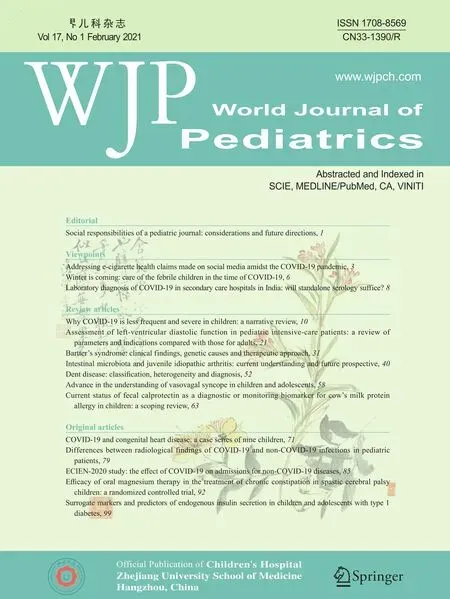Social responsibilities of a pediatric journal:considerations and future directions
Li-Li Yang ·Xian-Jun Wang ·Qi Qi·Si-Yun Xu·Yi-Cheng Xie·Zheng-Yan Zhao·Qiang Shu
Dr.Lundberg,the former editor ofJAMA,elucidated many social responsibilities for medical journal editing as early as 1987 [1].During the pandemic,a medical journal should highlight its social responsibilities in publishing high-quality contents,promoting education to the health care providers and providing readers with the timely and accurate information [1].At the time of this editorial published,the global cases of coronavirus disease 2019 (COVID-19) had surpassed 85 million.The pandemic and its resulting economic,health,and educational disruptions have affected all aspects of the youth’s lives [2].Quarantine and social isolation,increased risks of child abuse and neglect,financially and psychologically stressed family members have led to negative mental outcomes in children and adolescents.Dr.Christakis is awaring that the adverse effects of COVID-19 on children are longitudinal and will not be recognized fully until 15 to 20 years later [3];notably,the youth population from the less developed countries and vulnerable pediatric populations are more vulnerable to be affected by the pandemic.As editors ofWorld Journal of Pediatrics(WJP),we think the main social responsibilities in response to the pandemic are to publish scientific,accurate and accessible information about pediatrics and COVID-19.
As of 31 December 2020,the journal has published 27 COVID-19-related articles covering various aspects of COVID-19 in children and adolescents.We published the first guidance for prevention,diagnosis and treatment of COVID-19 in children in the early February of 2020 [4— 6].We also published a special issue on“COVID-19 and children”,which provides a comprehensive overview of the strategies and management for children with COVID-19 [7].These articles are closely relevant to clinical practice,which have provided first-hand diagnosis and treatment guidance to pediatricians and researchers.All the COVID-19-related articles are freely available to the world.
WJPis committed to high-standard publication ethics,guaranteeing timely,scientific and fair peer-reviewing process,as well as high-efficient production flow.The journal adheres to high-quality-oriented publication while keeping rapid publication during the pandemic.We have adopted the same high standards for COVID-19-related articles.Fast publication relies on efficient communications among editors,authors,reviewers as well as publishers.
For promoting education in healthcare workers and the general public,the journal has been working hard on increasing its visibility.We optimized the journal’s publication model to make more high-quality articles to be freely available to the public.In 2017,WJPtransited from a subscription journal to a hybrid open access journal.Now the journal is preparing for sustainable transition to fully open access.In addition to accessibility of contents,we also have been focusing on increasing accessibility of language.We have translated academic articles into popular science reports in Chinese,thereby increasing the visibility of these articles among the general public in China.In 2020,WJPlaunched its own account on Twitter with the name of“World Journal of Pediatrics”and account of“@World_J_Pediatr”.We will continue to promote the journal articles worldwide and make more high-quality articles available via social media.In response to Bandara’s request [8],WJPwill create more high-quality,easy to understand resources at the adolescents’literacy level through social media.
Since 2005,the journal has been devoting to reporting scientific achievements and popularization of pediatric knowledge.We have been endeavoring to developWJPas a forum for academic communication and medical education in the past 16 years.WJPwill all along contribute to the better health of the youth.The followings are the journal’s several future directions in response to the pandemic:(1) highlighting the potential longitudinal impact of COVID-19 on psychosocial health of the youth population and their families;(2) bringing attention of the health and care needs of vulnerable pediatric population;(3) Raising concerns about healthcare issues of the pediatric population in less developed countries.
Author contributionsYLL and WXJ contributed equally to this paper.All authors reviewed,revised,and approved the final manuscript.
FundingThis study was supported by China STEM Journal Excellence Action Plan (C-099).
Compliance with ethical standards
Ethical approvalNot needed.
Conflict of interestThe authors declare that they have no financial or non-financial conflict of interest.
 World Journal of Pediatrics2021年1期
World Journal of Pediatrics2021年1期
- World Journal of Pediatrics的其它文章
- Why COVID-19 is less frequent and severe in children:a narrative review
- Laboratory diagnosis of COVID-19 in secondary care hospitals in India:will standalone serology suffice?
- Winter is coming:care of the febrile children in the time of COVID-19
- Addressing e-cigarette health claims made on social media amidst the COVID-19 pandemic
- Surrogate markers and predictors of endogenous insulin secretion in children and adolescents with type 1 diabetes
- Efficacy of oral magnesium therapy in the treatment of chronic constipation in spastic cerebral palsy children:a randomized controlled trial
